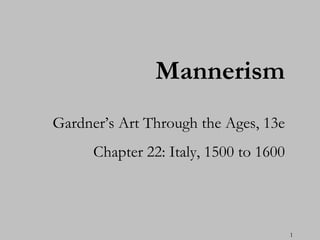
Mannerism
- 1. Mannerism Gardner’s Art Through the Ages, 13e Chapter 22: Italy, 1500 to 1600 1
- 2. 22.3 Mannerism • Understand Mannerism as an artificial style in contrast to the naturalism of the High Renaissance. • Examine Mannerism as interested in expressive forms of art rather than classical forms. • Explore the lives and works of key artists of the Mannerist style. • Recognize the artistic elements of Mannerist painting, sculpture, and architecture. 2
- 3. Mannerist Painting • Recognize basic features of Mannerism – Elongated figures – Figura Serpentinata – Less emphasis on balance, symmetry, and rational composition (values of High Renaissance) – Unusual lighting effects • Compare and contrast Mannerist painting with that of the High Renaissance 3
- 4. JACOPO DA PONTORMO, Entombment of Christ, Capponi Chapel, Santa Felicità, Florence, Italy, 1525–1528. Oil on wood, 10’ 3” x 6’ 4”. 4
- 5. PARMIGIANINO, Madonna with the Long Neck, from the Baiardi Chapel, Santa Maria dei Servi, Parma,Italy, 1534–1540. Oil on wood, 7’ 1” x 4’ 4”. Galleria degli Uffizi, Florence. 5
- 6. BRONZINO, Venus, Cupid, Folly, and Time, ca. 1546. Oil on wood, 5’ 1” x 4’ 8 1/4”. National Gallery, London. 6
- 7. Mannerist Portraiture • Examine the portrait as an expressive form of art. • Explore the lives and works of key artists of the Mannerist style. 7
- 8. BRONZINO, Portrait of a Young Man, ca. 1530–1545. Oil on wood, 3’ 1 1/2” x 2’ 5 1/2”. Metropolitan Museum of Art, New York 8
- 9. SOFONISBA ANGUISSOLA, Portrait of the Artist’s Sisters and Brother, ca. 1555. Oil on panel, 2’ 5 1/4” x 3’ 1 1/2”. Methuen Collection, Corsham Court, Wiltshire. 9
- 10. TINTORETTO, Last Supper, 1594. Oil on canvas, 12’ x 18’ 8”. San Giorgio Maggiore, Venice. 10
- 11. PAOLO VERONESE, Christ in the House of Levi, from the refectory of Santi Giovanni e Paolo, Venice, Italy, 1573. Oil on canvas, 18’ 3” x 42’. Galleria dell’Accademia, Venice. 11
- 12. PAOLO VERONESE, Triumph of Venice, ca. 1585. Oil on canvas, 29’ 8” x 19’. Ceiling of the Hall of the Grand Council, Doge’s Palace, Venice. 12
- 13. Mannerist Sculpture • Examine the expressive forms of sculpture. • Recognize the artistic elements of Mannerist sculpture. 13
- 14. CORREGGIO, Assumption of the Virgin, 1526–1530. Fresco, 35’ 10” x 37’ 11”. Parma Cathedral, Parma. 14
- 15. BENVENUTO CELLINI, Saltcellar of Francis I, 1540-1543. Gold, enamel, and ebony, 10 ¼” X 1’ 1’ 1/8”. Kunsthisotrisches Museum, Vienna. 15
- 16. GIOVANNI DA BOLOGNA, Abduction of the Sabine Women, Loggia dei Lanzi, Piazza della Signoria, Florence, Italy, 1579–1583. Marble, 13’ 5 1/2” high. 16
- 17. Mannerist Architecture • Spot idiosyncrasies of Mannerist architecture • Compare and contrast High Renaissance architecture and Mannerist architecture 17
- 18. GIULIO ROMANO, interior courtyard facade of the Palazzo del Tè, Mantua, Italy, 1525–1535. 18
- 19. Examine the Mannerist elements in Michelangelo’s design for the vestibule of the Laurentian Library in Florence. MICHAELANGELO BUONARROTI, vestibule of the Laurentian Library, Florence, Italy, 1524-1534; staircase, 1558-1559. 19
- 20. GIACOMO DELLA PORTA, facade of Il Gesù, Rome, Italy, ca. 1575–1584. 20
- 21. GIACOMO DA VIGNOLA, plan of Il Gesù, Rome, Italy, 1568. (1) dome, (2) nave, (3) chapel. 21
- 22. Discussion Questions What are the elements of Mannerist art and sculpture that are different from the art of the High Renaissance? What plans and theories of the architect Palladio continue to be seen in architecture to this day? 22
